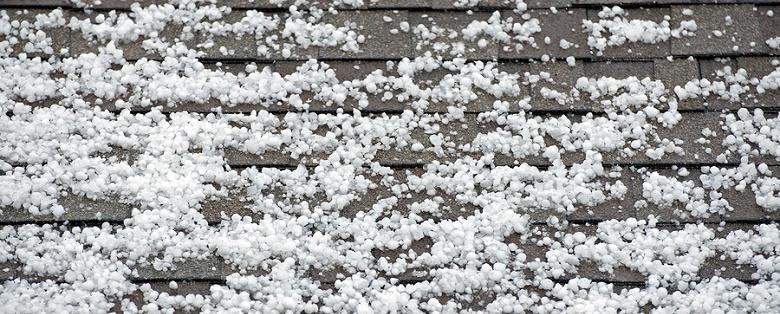
In its various forms, hail can cause severe damage to roofs, reducing their effectiveness and increasing the chance of material degradation. Occurring as anything from small, sharp crystals to huge balls of ice, hail can cause varying degrees of destruction to different materials, sometimes to the point that roofers should be called to make repairs. Homeowners may not even realize they have sustained hail damage, yet it is important to identify it so that appropriate repairs can be planned.
Hail Damage on Asphalt Shingles
Asphalt shingles are fairly durable in most conditions; however, they can suffer hail damage. Generally speaking, hail must be about 1 inch in diameter before it causes damage to asphalt roofs. Age and condition can make shingles more susceptible, even with smaller hail. Impact from larger hail can cause dents in the surface, creating cracks and splits underneath and loosening shingle adhesive, increasing the possibility that leaks will start.
Hail can also wear away the protective granule coating on asphalt shingles. Asphalt granules collecting in the gutters are one of the primary signs of hail damage, as are many little impact dents across the surface of the shingles. If either of these symptoms is noticed, homeowners should call to have roofers inspect the damage and determine whether repairs are necessary.
Hail Damage on Metal Roofs
Hail damage is usually much easier to see on metal roofs; however, it is also much more destructive. Depending on the thickness and type of the metal, ice balls of various sizes can cause substantial damage to metal panels and even durable metal shingles. This can disrupt the way sheets lay against the underlayment and decking.
Metal roofing can also suffer scuffs and discolorations due to hail splatter, which is slushy precipitation mixed with ice. Not only is this damage on metal unsightly, as dents and discolorations are easy to spot, it can increase the chance of corrosion at the impact points. Dented metal panels are also more susceptible to leaks or wind damage.
Hail Damage on Other Roof Types
Asphalt shingles and metal are not the only types of roofing material that can suffer hail damage. Hail can leave dents and splits on wood shingles and shakes, causing loss of water tightness. It may chip, crack, or break shingles and tiles made of concrete and ceramic. Dents and cracks in BUR and membrane roofing may be an indicator of damage from hail as well.
Even slate, which is one of the strongest materials used by roofers today, can sustain chips, cracks, and breaks when hit with larger diameter ice balls. Flashing, trims, and gutters on any home can be damaged to where it must be repaired to function properly.
Although smaller hail may not affect any of these materials, anything above an inch in diameter can be highly destructive, leaving cracks, chips, splits and dents that can drastically affect the performance of different roofs. Hail damage can be deceiving, appearing to affect only the top surface of the roof; however, leaking and other problems frequently follow. Homeowners who recognize any of the above signs or suspect they could have hail damage should contact local roofers that can climb up and take a closer look!
